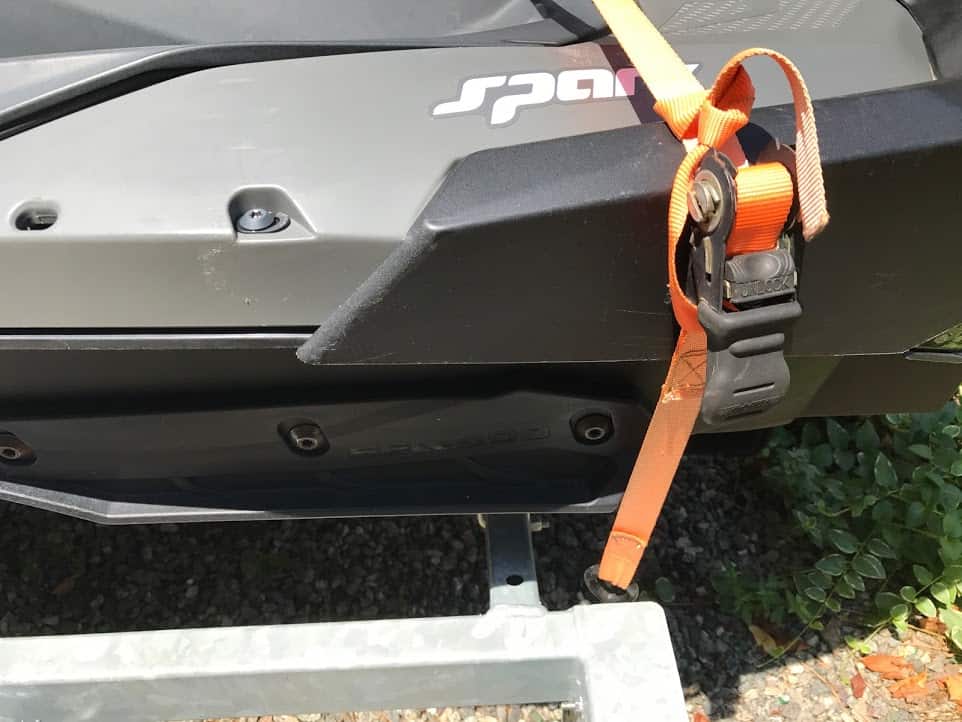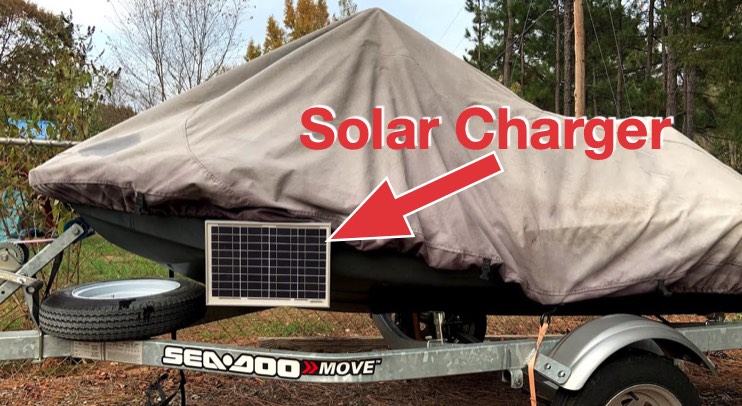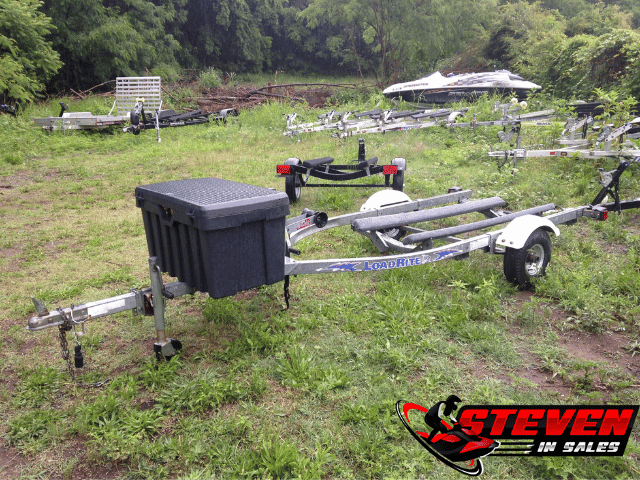Trailers often play the role of the unsung heroes in the world of jet skis. They’re the trusty sidekicks that make it all possible, allowing us to transport our water toys to those beautiful locations.
Now, you might think, “Trailers are pretty straightforward, right? What items could I possibly need?” Well, hold onto your life vests because trailers do indeed come with their own set of must-have gear that can make your life a whole lot easier.
In this post, we’re going to shine a spotlight on these essential watercraft trailer gear. So, let’s dive in and get your trailer all decked out for the road!
1. Adjustable Jack For Getting Off The Ball
The tongue jack (Amazon Link Ad)is a needed item for anyone with any trailer.
Without the tongue jack, you’re putting the nose directly on the ground. Not only does this make it harder to pick them up, but damages the frame and coupler.
Here is a short list of why a tongue jack is needed:
- Makes getting them off your truck easier.
- Easier to move the ski around the garage and other flat surfaces.
- Levels the PWC for oil changes and keeps water out of places it shouldn’t be when on land.
- Helps with cleaning, as you can prop them up higher by putting something under the jack.
- Something to grab and help get the trailer on the ball of your truck.
The only downside I’ve seen from tongue jacks is that they can get bent over time. People either damage them or use a jack too small.
Otherwise, a tongue jack is a need!
2. A Spare Tire
Having a spare tire is simply a good idea for any trailer!
From my years of selling and owning jet skis, I’ve learned that people don’t take care of their jet skis trailers, especially their tires. Most of the time, tires are dry rotted and ready to fail, and often fail at the worst spots.
Sometimes it’s something in the road that damages the tire of your trailer, and you’ll need to replace it.
Here is a link to the most common watercraft trailer tire (Amazon Link Ad), but make sure you get one that is the correct size and lug pattern for your trailer. If you’re not certain, your local dealership will carry several, or your local tire shop can get the tires too.
You will need a spare tire holder (Amazon Link Ad) or somewhere in your car or trailers to keep the spare tire.
3. Tire Changing Kit
PWC trailers do not come with the tools you’ll need to change the tire WHEN it fails.
So, it’s a good idea to keep some basic tools around to help you change the tire on your trailer. You can keep it in your car, or get a cargo box for your trailer.
Here is a list of tools you’ll need to change your trailers tires.
- Wheel chock.
- Jack.
- Socket that fits your lug nuts.
- Impact or breaker bar.
While this may seem complicated, the good news is that you can buy kits like this one here (Amazon Link Ad) that has everything you’ll need. These kits run off your car’s 12-volt system and make your life way easier when you need to replace a tire.
4. Tongue Box / Cargo Box
To help you carry all the gear for your trailer, you can get a cargo box.
The cargo box mounts in front of the PWC on the front part of the trailer. On a single it’s a tight fit, and you can only use small cargo boxes (Amazon Link Ad). For doubles, you tend to get more room and can use a bigger cargo box (Amazon Link Ad).
The number of things you can carry in that box makes it so important. You can keep everything in this list in the cargo box, and it’s always there when you need them.
5. Straps To Hold The Rear Down

Tie-down straps are used to secure the rear of your waverunner to the trailer. You got the front bow hook, but the rear still needs something to keep it from sliding out or bouncing too much on the bumps.
You can get ratchet straps here (Amazon Link Ad).
Tip: How you use a strap is simple. You place the strap through the center hole and then back to the top. Remember – Center then Top.
There has been a few times that a rear strap has saved the waverunner I was towing. For example, I had the front strap break and if it wasn’t for the rear strap it would landed up on the road.
Overtime straps wear out due to the sun and water. The front straps seem to be the ones that fail first, so it’s important you replace it every 5 years. The same goes for rear straps, they should be replaced every 5 years, especially if they start to tear or fade.
I cover similar PWC gear here.
6. Wheel Chocks So It Doesn’t Roll Away
Blocking or chocking the wheels off is very important when storing the trailer or doing any work on the watercraft.
You can get wheel chocks just about anywhere, they sell plastic and rubber ones. I find the rubber ones last longer and give better grip, I’ve snapped a few plastic ones.
You can get rubber wheel chocks here (Amazon Link Ad).
I suggest getting at least two wheel chocks as it will cover most tire configurations. I like to chock off the front and rear of the tire no matter the direction of the hill, and to accomplish this you may need more than two chocks.
Wheel chocks can also be helpful when launching your ski and keeping your truck from going into the water, as talked about in the video below.
7. Post Guides For Backing Up
Smaller trailers are hard to back up at boat ramps, so they need a little help with boat post guides.
A boat post guide does two things, lets you know where the far left and right and helps keep the rear of your boat from floating away when trying to load and unload.
You can buy post guide here (Amazon Link Ad).
8. Lock And Security Options
You need a lock to keep people from hooking up and driving off with your PWC.
A coupler lock (Amazon Link Ad) will work fine for most people, but if you need more security, then check out my post here.
Don’t forget to pick up the locking hitch-pin (Amazon Link Ad). Even if you put a lock in the trailer, anyone can come up and pull the hitch out of your truck and hook up to their tuck; a hitch lock will keep this from happening.
9. Light Adapter
Most trailers use the flat trailer plug (Amazon Link Ad), while all truck manufacturers have gone to the round trailer plug (Amazon Link Ad).
More than likely, you’ll need the adapters so your lights work. The good news is that these trailer light adapters (Amazon Link Ad) are simple and affordable.
Trailer light adapters are often overlooked by beginners when it comes to trailer gear.
10. Backup Camera
Most cars and trucks are required to have a backup camera when sold new, but if you don’t have one, I suggest getting one installed.
A backup camera (Amazon Link Ad) makes hooking up to a trailer a lot easier.
Before cameras there was a lot of guessing and restarting, it was a frustrating time.
11. Jet Ski Stand
Not so much an accessory, but something similar that takes up less space.
You can transfer your jet ski to a stand that takes up less space and is easier to move around. It also makes it easier to clean and work on your jet ski when it’s on a cart stand.
To learn more about stands, check out my post here.
12. Lube & Grease Your Wheel Bearings
You need to routinely grease and lube your bearings, as shown in the video below.
Make sure to use marine rated grease (Amazon Link Ad) for your bearings as they will be exposed to water.
Not only that, but you need to lubricate all moving metal parts, like the winch.
Just don’t put any lube on parts that people’s feet or hands will touch. Coating the trailer will not help with saltwater, rinse the trailer down with fresh water after riding in salt water is the best solution.
13. Torque Wrench
Before every ride, and especially at the start of the riding season, you need to check the torque of the wheel lug nuts.
Over time, the lug nuts come loose and will work their way out if you’re not checking them. I’ve had it happen to my car, so make sure to check them too!
You can give them a snug fit with a beaker bar or similar, but you run the risk of over torquing the lug nuts, so you need to use a torque wrench (Amazon Link Ad).
For most trailers, you torque the lugs to 90lb/ft, but consult your owner’s manual for the exact measurement.
Here is a great video showing you how to use a torque wrench if you’ve never used one before.
14. Dolly
If you own many trailers and need to move them around, the tongue jack may not be enough and you’ll need a dolly.
A dolly hooks to the ball and has wheels to make moving around a lot easier. It’s often easier to use than hooking up to the truck and moving the trailer for short distances.
At the dealership, I would use them to move jet skis around the lot, as it was just easier than getting the ATV or forklift.
I suggest trailer dollies with solid tires (Amazon Link Ad), as the other ones go flat fast.
15. Solar Battery Charger

Not so much an accessory for trailers, but a huge help for the jet ski that is sitting on the trailer.
Watercraft batteries go flat when not used, and as covered in my post on why you need a solar battery charger, a solar charger can help keep them alive.
If you keep your jet ski on the trailer when you’re not using it, then installing a small solar battery charger on the frame is a great idea. The solar panel does not need to be in direct sunlight, so putting off to the side or installing it on top of the cargo box lid are great options.
Storing Your Trailer Upright
Since I get so many people asking if it’s okay to store their trailers upright or on the side because space is a premium where they keep it, I’m going to answer that here.
It’s fine, trailers don’t care how they’re stored, so long as the proper maintenance is done on them. If anything, keeping the wheels off the ground and covered is a huge benefit!
The problem you’ll run into is that trailers are heavy. I’ve lifted a few trailers to have the rear rest on the ground and the tongue up in the air, and it’s a pain. Of course, the trailer was empty. Flipping it on to the side was easier if you want to keep it against a wall, as it will take up less space that way.
Just make sure you don’t throw out your back as they’re heavy and don’t store it in a way that it could fall down and hurt someone one.
Unplug Lights When Backing Into Water?
Another common question I get is about unplugging the lights from your truck before backing the trailer into the water.
Ideally, you should disconnect the lights from your trailers.
Then there is what I do, keep it connected. I’ve backed down many trailers of all variations into the water and never had any issue. Life is not like the movies, and I’m sure many people on the forums will argue with me, but I’ve seen from reality is to be different. I will say to unplug them if you ask me in person, but I don’t do it, so it’s a do as I say and not as I do situation.
I’m sure there will be one guy whose whole light system gets messed up because he didn’t unplug his trailer lights before putting it in the water, but for me, I’ve got bigger issues to worry about.






Can you please post a picture or video of how to strap the jet ski to the trailer? I have just the one attached to the winch. I bought straps but can’t find where to place them. Thank you
Hi Steven,
First time buyer looking for a PWC trailer. It’s confusing – painted, galvanized, aluminum.
I am thinking aluminum is best. Do I need an “extended” PWC trailer that is longer? What are the advantages of this?
Looking forward to your thoughts.
Aluminum is the best for sure, but for extended it depends on what you’re putting on the trailer. If its big like GTX or FX then an Extended model would be good. If its a Spark or EX then any small jet ski trailer you can find will work. The good news is that many, if not all, jet ski trailers are adjustable if they’ve been made in the last 20 years. But watercraft have gotten bigger then they used to be 20 years ago.